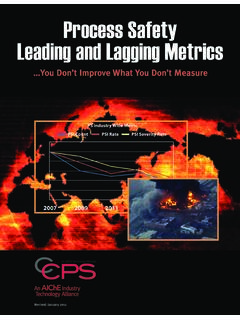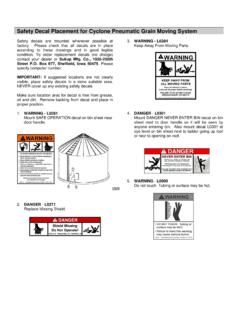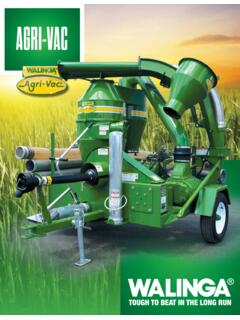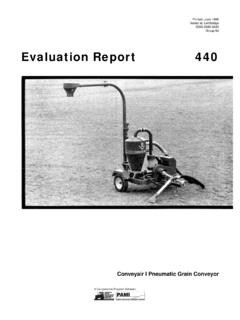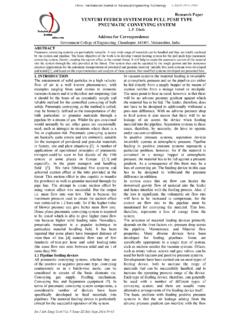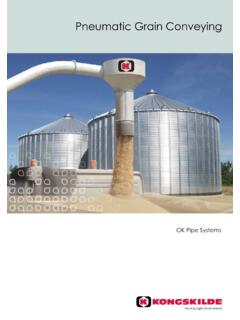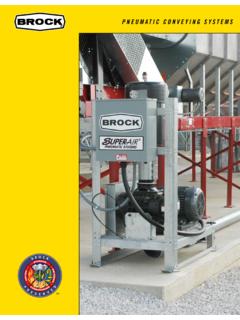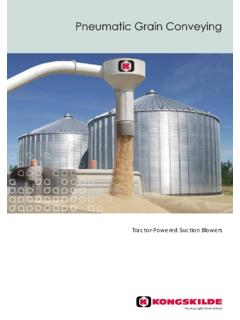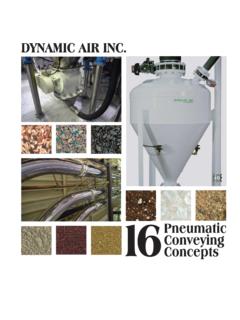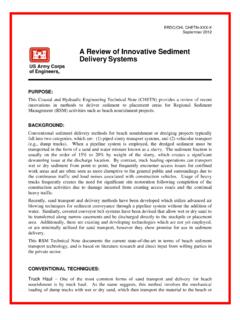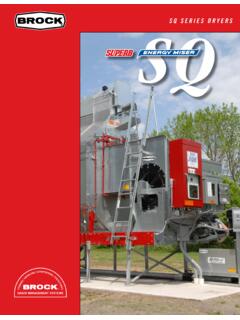Transcription of Introduction to Pneumatic Conveying of Solids - AIChE
1 Introduction to Pneumatic Conveying of SolidsKarl JacobThe Dow Chemical CompanyEngineering Sciences/ Solids ProcessingMidland, for this webinar Understand various modes of Conveying of Solids Learn how to decide on Conveying configuration Examine key aspects of design of Conveying systems Recognize the various Conveying system components Learn how to approach common Conveying problemsWhat is Pneumatic Conveying ? Pneumatic Conveying is the movement of Solids through pipe using gas (usually air) as the motive force. It differs from hydraulic or slurry Conveying in that the gas expands continuously along the pipe length. The flow regime in the pipe depends greatly on the ratio of Solids to gas and the particle use Pneumatic Conveying to move bulk Solids ? With the appropriate choice of system , material can be transported with minimal degradation Little or no exposure of the product to the environment Can transport relatively long distances (several thousand feet) Excellent for multiple sources and multiple destinations Ability to transport material which might be air, moisture, etc.
2 Sensitive Compared to mechanical conveyors, relative ease in system routing especially elevation changes Interfaces well with a variety of transportation modes truck, railcars, ships High reliability of system with comparatively few moving partsPotential disadvantages Product degradation as a result of incorrectly designed system Pipe/component wear Not suitable for long distance (beyond a few thousand feet) Conveying it is difficult to overcome the gas expansion issue! Conveying Flow RegimesHorizontal FlowDecreasing gas velocityConveying Flow RegimesHorizontal Flow Decreasing gas velocityPneumatic Conveying Phase DiagramDense phase vs. dilute Dense phase Low velocity Low attrition High pressure Comparatively high cost Small pipe size High loadings Dilute phase High velocity Can have very high attrition Pressure typically < 15 psig Low cost Larger pipe size Low loadings (<10)Actual Phase Diagram -StyroporMaterial: Styropor (BASF)dp= p= 1050 kg/m3D = mm (SS)From Pneumatic Conveying of Solids , Marcus, et.
3 Design issues Number of sources and destinations? This is usually determined by plant conditions. Dense phase vs. dilute phase? Push vs. pull?Addressing each of the above questions will largely dictate the type of system that needs to be vs. Pull Push generally a pressure system operating above atmospheric pressure Pull a vacuum system operating below atmospheric pressure -~ 7 psia is practical lower limit Choice of push vs. pull depends greatly # of sources and destinations some configurationPush vs. Pull Selection Guide# of sources# of destinationsVacuum or pressure system ?11either1 ManyPressure preferredMany1 Vacuum preferredManyManyeitherTypical Pull ConfigurationKey design issue is to insure that you can pull from the longest pipe configuration!Typical Push ConfigurationIn parallel to the pull system , it is important that the system be designed to be able to handle the required Conveying rate to the furthest Fundamentals In contrast to fluid flow with liquids, the Conveying gas expands along the length of the pipe and that has a considerable effect of the design and operation Pneumatic Conveying systems Contributions to pressure drop in a Conveying system Head loss due to elevation change Solids acceleration Gas friction loss Solids friction loss Bend or elbow or fitting lossDilute phase pressure drop Ptotal= Paccel+ Plift+ Pbends+ Pair+ PsolidsEach component of pressure drop can have a significant impact on Conveying system performanceExamplesConveying of rubber high Solids frictionConveying of elastic materials always acceleratingTruck unloading high lift componentTortuous Conveying path high bend pressure drop Pressure drop due to air In this particular case.
4 We use the conventional friction factor formulation we learned in fluid mechanics If the Conveying line is operated as air only , then this number is relatively easy to check with either a gauge or hand held manometer near the blower. Note that the gas density needs to be evaluated at each point in the pipe consequently, design calculations usually are done by breaking the line into many small Pressure drop due to particle acceleration The particles are required to accelerate after being introduced into the line note that this is a one time effect in the calculation Here v and ugare the particle and gas velocities respectivelypgaccuvP Pressure drop due to lift Standard treatment here as we would expectHgPplift )1( is the voidage and for dilute phase systems will tend to be or greaterPressure drop due to bends Bends are quite common in Conveying systems and numerous correlations have been developed to calculate bend pressure drop Note that when measuring pressure drop in the field, it needs to be measured several pipe diameters downstream of the exit of the elbow to properly account for particle reacceleration after the )
5 1(2 B is a bend factor usually taken as being for a long radius elbowPressure drop due to Solids friction The Solids friction component mirrors that of gas pressure loss except for now we have a special Solids friction factor There are some existing correlations for Z both in the vertical and horizontal direction The friction factor can also be determined from either pilot plant work or by careful analysis of a production plantDLvPgZsolids22 Note the impact of system loading on pressure drop!Saltation When the gas velocity is slowly decreased during dilute phase Conveying , material will begin to deposit or salt out at the bottom of horizontal sections of the Conveying system . Saltation is loading dependent typically the higher the loading, the higher the saltation velocity No single correlation predicts saltation across all gas and particle parameters For plastic pellet systems, Rizk s equation has been found to work well Fine particle systems tend to have cohesion and so, although it seems somewhat counterintuitive, saltation velocity will increase a function of particle size.)
6 This effect is well described by the equation of Matsumoto (1977).Saltation Equation -Rizk gDvs101 Rizk s equationwhere is the phase ratio (kgs of solid/kg of gas)vsis the saltation velocityD is the pipe diameter = + = + that the particle size, dp, must be in millimeters!!!How do we design a system ? Select configuration push vs. pull Determine preliminary layout Guess pipe/tube size Calculate saltation Estimate pressure drop Calculate volume of blower Select blower Calculate pressure drop check if pressure drop, velocity and pipe size agree with estimates if not, iterate based on initial solution Conveying system Components Air Movers Feed systems Pipe/Tube Dust Collector Couplings/FlangesAir Movers Rotary Lobe Blowers often called Roots blowers Fans CompressorsTypical air mover performance curvespressurevolumeFanCompressorBlowerL obe Blower Performance CurvesPressureVacuumRotary Lobe BlowerThese are true positive displacement devices.
7 Some suppliers will provide a tri-lobe model in order to cut down on the pulsations in the from RootsCommon feed systems Rotary valve (also star valve) the most common feeder used in Conveying systems considerable versatility good turn-up/turn down Slide valves Screw feeder Double flapper valves Venturis Pneumatic wandsRotary cutaway view of a commercial rotary valve. Can be connected to fixed speed or variable speed drive Always need to be concerned about tip wear typical new clearances are 4-6 mils Need to consider valve leakage during design leakage can sabotage an otherwise well-designed systemPipe & Tube Light gauge (Sch. 10) pipe or tube is routinely used for Conveying systems Materials of construction include stainless steel, CS and aluminum Aluminum is frequently used in the Conveying of plastics Particular attention needs to be given to bends/elbows where erosive wear can be an issue, even with soft products ( polymers) With the wide selection of pipe and tube sizes, it affords the Conveying system designer an excellent opportunity for optimal system designCouplings/Flanges Couplings represent an inexpensive and easy choice for Conveying system tube connections.
8 They are typically used on tube systems and come in a variety of standard sizes. They are relatively easy to assemble/disassemble. However, if stressed laterally, they can be prone to misalignment. By comparison, flanges are used in pipe systems and commonly used on higher pressure (>15 psig) dense phase systems. A number of companies now sell self-aligning flanges which help to minimize off-grade particles and Conveying system phase Conveying Dense phase is recommended when product attrition and product quality demands our utmost attention Typically is characterized by low velocity Conveying Conveying mode depends greatly on particle characteristics Pressures in systems routinely between 1 and 6 barg A priori prediction of performance extremely difficult system performance is all about control of plugs of material Stresses due to large plugs in piping systems can be difficult to controlConveying regimes for dense phase Pneumatic Conveying Three reasonably distinct Conveying modes are observed when Conveying bulk Solids in dense phase Large materials like plastic pellets will naturally form slugs of material in the Conveying line interspersed between pockets of air Medium sized granular materials (example 100-1000 m)
9 Do not make well formed slugs in the line the Conveying is characterized by the formation and degradation of degenerate slugs in the line some type of air assist is required to maintain slug control. Care must be taken that too much air isn t added to the line causing the system to be in dilute phase Fine materials (<50 m) will naturally form very long slugs in the line, consequently some sort of plug breaking mechanism must be installed in order that the pressure drop across the system does not become inordinately high Boosters Air Injection encountered problems Increasing Conveying system throughput Attrition/floss formation/pipe erosion Line failure in dense phase systems Plugging due to poor layoutIncreasing system throughput Quite commonly, the capacity of a dilute phase Conveying system needs to be increased. Take, for example, a system operating at ~12 psig, near the relief of the positive displacement blower. The velocity at the pick-up point (where the Solids are introduced into the system ) is 5000 fpm, well above the saltation velocity of 4000 fpm.
10 What should she or he do?Phase Diagramgas velocityPressure dropAir only pressure dropm1m2m3m3>m2>m1 ABAttrition/Floss formation Attrition is a key issue in the Conveying of Solids and can lead to any of the following issues: Poor product performance Environmental, Safety and Health issues Changes in the flow properties of material Polymeric materials can be problematic due to the formation of either dust or floss (also streamers or angel hair) The key in these situation is velocity control!! Typically attrition is a strong function of velocity. If the velocity in a dilute phase system can be reduced, this represents a legitimate option for reduction of velocity3-5 Line failure in dense phase systems This can be a very SERIOUS issue. During the dense phase Conveying , it is not unusual to see the line moving or vibrating as slugs make their way through the Conveying line. Tremendous forces are encountered as a plug switches directions, particularly around horizontal elbows example, in large systems it is not uncommon to see individual plug weights on the order of 500 lbs.


